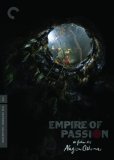| Reviews & Columns |
|
Reviews DVD TV on DVD Blu-ray 4K UHD International DVDs In Theaters Reviews by Studio Video Games Features Collector Series DVDs Easter Egg Database Interviews DVD Talk Radio Feature Articles Columns Anime Talk DVD Savant Horror DVDs The M.O.D. Squad Art House HD Talk Silent DVD
|
DVD Talk Forum |
|
|
| Resources |
|
DVD Price Search Customer Service #'s RCE Info Links |
|
Columns
|
|
|
Empire of Passion - Criterion Collection
The Criterion Collection // Unrated // April 28, 2009
List Price: $29.95 [Buy now and save at Amazon]
The Film:
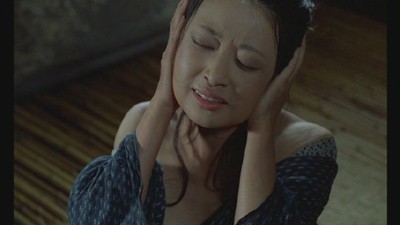 Though considered to be a complimentary film -- a pseudo-sequel of sorts -- to his controversial erotic drama In the Realm of the Senses, it's important to bear in mind that Nagisa Oshima's Empire of Passion (L'empire de la passion, or Ai no borea) stands alone as an outstanding "kaidan" film on its own terms. Those familiar with the likes of Kenji Mizoguchi's Ugetsu and Kaneto Shindo's Onibaba will have an easy time grasping this Japanese ghost story's structure, a framework that relies heavily on atmosphere, subtle physical drama between the living and the dead, and an abundance of allegory underneath seemingly simple and, oftentimes, passionate theatrics. Alongside these bullet points, Oshima also carries over familiar themes that revolve around passion's destructive power, transforming his spooky follow-up into a more thoroughly involving picture than its controversial inspiration.
Though considered to be a complimentary film -- a pseudo-sequel of sorts -- to his controversial erotic drama In the Realm of the Senses, it's important to bear in mind that Nagisa Oshima's Empire of Passion (L'empire de la passion, or Ai no borea) stands alone as an outstanding "kaidan" film on its own terms. Those familiar with the likes of Kenji Mizoguchi's Ugetsu and Kaneto Shindo's Onibaba will have an easy time grasping this Japanese ghost story's structure, a framework that relies heavily on atmosphere, subtle physical drama between the living and the dead, and an abundance of allegory underneath seemingly simple and, oftentimes, passionate theatrics. Alongside these bullet points, Oshima also carries over familiar themes that revolve around passion's destructive power, transforming his spooky follow-up into a more thoroughly involving picture than its controversial inspiration.
Set in late 19th century Japan, Empire of Passion revolves around deceit and, ultimately, murder, with sexual gratification as a motivator. Seki (Kazuko Yoshiyuki), a simple wife to a rickshaw driver named Gisaburo (Takahiro Tamura) and servant to a house in her town, reluctantly begins an affair with an aggressive ex-soldier named Toyoji (Tatsuya Fuji, the male lead from In the Realm of the Senses). Their initial encounter leads to a series of sexual rendezvous -- toned down from those that Oshima photographed from In the Realm of the Senses -- that would ultimately cloud Seki's mind with delusions of happiness and satisfaction outside of her domestically-driven, mundane life. For her to spend her life with her aggressive courter, a charming man who brings her fruit dumplings and compliments in ways unlike her husband, the two of them arrange a happenstance murder to rid of Seki's husband.
When Gisaburo's ghost returns to haunt the city and, ultimately, her household, they fear that their secret will surface from underneath the leaves and sludge covering his body at the bottom of a nearby well. Oshima concentrates on the concept of ethereal figures being mere extensions of people instead of purely frightening apparitions, though all of the townsfolk would prefer that the rickshaw driver's ghost wouldn't continue to haunt their area. Instead, Seki's husband is more like an element of her conscience returning to make her life as restless as his conclusion. He's neither aggressive nor complacent in his state, but more of the sole piece of evidence that'll convict her and her lover in a time where bloody knives and fingerprints couldn't convict wrongdoers and simple gossip amid townsfolk could taint those without a formal conviction. The limited number of direct scare devices present in Empire of could deflect more casual horror fans, but the rickshaw driver's ghastly presence is certain to rustle up at least a few mild shivers.
Those familiar with the many levels of Japanese horror, from Masaki Kobayashi's Kwaidan itself to modern pieces like Ju-on (The Grudge) and Ringu (The Ring), will have an easy time grasping the notion that subtle ambient suspense and well-conceived photography are Oshima's primary tools at play in his stab at at campfire folklore. It's a traditional Japanese ghost story through and through, with regret and temerity as the essentials intermingled within the compartmentalized narrative. The plot is simple and streamlined with little development, instead relying on both traditional storytelling and Oshima's fervent connection with eroticism as its draws. It's not geared to surprise us as much as it's out to mildly thrill underneath a layer of compelling dramatics bouncing between the leads and a supple sense of aesthetic atmosphere. Though the drama within Seki's love triangle compels to a few mild degrees, the dynamics between them achieve much more once the supernatural elements sneak into the picture. Watching Seki fetch high-content alcohol for her ghostly husband in the middle of the night, along with hearing his voice during an reenacted situation with Toyoji to respark their relationship, transforms Oshima's tone into one of dark comedy and foreboding, swelling tension.
Yoshio Miyajima's cinematography work in Empire of Passion becomes a key element behind its memorable vibe, as it paints the story with equally beautiful and eerie mise-en-scene. With Oshima's eyes for visual motifs, the two blend several symbols together for dramatic effect, one of the most obvious metaphorical symbols is the usage of the circle to emphasize the cyclical nature of the film. Through rotating wheels and the opening at the top of a well in which we see the seasons changing, it conveys a sense of fluid movement throughout time in a striking fashion. It might not sound like much of a time dynamic to watch rickshaw spokes spin and a mixture of leaves and snowflakes fall into a watery grave, but they interact with the traditional "kaidan" elements in an immensely engaging fashion. Also, it's obvious that Oshima really made an effort to make his ghost story a more accessible film through the camera work, as it covers up the minimal sexual content with strategically-placed jettison planks of wood and pieces of fabric -- along with thoughtfully-arranged body parts and shadows.
Unlike In the Realm of the Senses, Empire of Passion takes on a more conventional form with the male-female dynamic. Where Sado Abe, the lead in Oshima's precursory film, takes on a dominant and violent disposition in her relationship, Seki takes very few strides to exercise any dominance in her relationships -- both with Toyoji and her husband. Instead, they only share a similar desperation in common, showcasing how Oshima focuses on the theme of feeling trapped underneath tradition and commonplace practices in different ways. Seki, as a character, doesn't stray far from gender archetypes put into motion with Japanese cinema's portrayal of 19th century women at the time, but she does show a few glimmers of breaking the mold within her murderous act -- though it was under the pressure of Toyoji. It's in their fleeting desperation, a glance at ensnaring something potent in a time of monotony, that their misguided relationship delivers a dose of potency revolving around the confusing, overwhelming and only partly gratifying nature of desire.
Empire of Passion communicates similar messages to In the Realm of the Senses regarding the consuming nature of sexual transgressions, but Oshima's decision to take it down a more convivial path as a ghost story wedged within tradition was a wise choice. In his decisions to tame that desire to create purely provocative cinema, he also allows some of his political concepts to be more readily accessible and discernible to the naked eye -- especially graspable once the film starts to crash towards its imminent conclusion. Through the eyes of Japanese horror fans and those whom appreciate classic ghost stories, it'll satisfy in all the same ways while adding dashes of Nagisa Oshima's erotically charged elucidations into its satisfying construction. Once you've seen the likes of the director's more aggressive neo-erotica, politically motivated experiment, it'll feel like a chill-inducing walk in the park -- and an immensely enjoyable one in the vein of other "kaidan" pictures of its ilk. As an avid fan of that particular genre, in both classic and contemporary concoctions, Empire of Passion left me gripped.
The DVD:
Empire of Passion comes presented in the Criterion Collection as spine #467 with attractively-designed artwork packaged in a standard clear keepcase. Inside is a rather beefy Booklet that contains still photographs from the film spliced in with several textual bits, including the essay "Love's Phantom" from critic/historian Tony Rayns (voice of the commentary from In the Realm of the Senses) and an interview from 1978 featuring Nagisa Oshima.
Video and Audio:
Criterion delivered a whopper of a transfer with their Blu-ray image for In the Realm of the Senses (reviewed here), and Empire of Passion -- though only available in a standard-definition treatment -- showcases the same level of concentration in color and detail levels. Presented in a densely saturated 1.66:1 anamorpic widescreen image, taken from the original 35mm camera negative through their Spirit Datacine process, it looks simply gorgeous. One of the best compliments dished out for older film transfers comes in saying that the image appears as if it has the same sort of polish that modern films have, a property that can easily be connected with this visual treatment.
Textures are etched out with eye-popping precision, the range of colors fluttering in the image throughout all seasons showcase splendid contrast and gradation, and the level of grain never oversteps its bounds beyond a natural film essence. The most impressive part of the transfer comes in its incredible depth of field rendering, which gives the image a remarkably three-dimensional feel highly noticeable in exterior shots. A few very, very mild instances of edge halos can be spotted in the starkly contrasted sequences and some mild grayish tinting in the generally inky shadows can be detected, but outside of that Empire of Passion offers its viewers an incredible exercise in dimensionality and color accuracy for a film from the late '70s.
A Japanese Mono track, defaulting to a single-channeled (1.0) track in audio systems, strongly supports the visual treatment. Much like other classic Japanese ghost stories from the '50s to the '70s, it makes excellent usage of the limited audio means -- and Criterion does a surprisingly vivid job in communicating that. Vocal clarity always stands distortion free and well-balanced, while the mild sound effects -- like the flickering of flames, crashing of boards, and the rickety creaks of an old rickshaw -- hold steady and strong even when they can't escape the limited audio presentation's hollowness in sound replication. Moreover, the musical accompaniment sounds equally as ambient and beautifully rendered, supporting the eerier sequences with all the proper musical cues and audibility levels.
Subtitles, which are typically excellent from Criterion, are only available in English to support the Japanese Mono track -- and, oddly, a mediocre English dub, an element that the label typically steers away from. For reference, the subtitles are not taken directly from the dub, and vice versa.
Special Features:
Interviews:
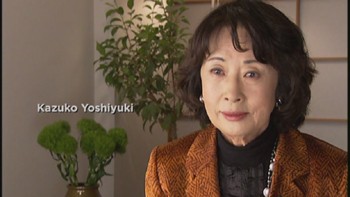 Two interview pieces are available, one newly-constructed piece with Tatsuya Fuji and Kazuko Yoshiyuki (17:04, 16x9) and another from 2003 entitled On the Set (13:17, 4x3) which gathers together production consultant Koji Wakamatsu and assistant directors Yusuke Narite and Yoichi Sai to discuss working with Nagisa Oshima on his films.
Two interview pieces are available, one newly-constructed piece with Tatsuya Fuji and Kazuko Yoshiyuki (17:04, 16x9) and another from 2003 entitled On the Set (13:17, 4x3) which gathers together production consultant Koji Wakamatsu and assistant directors Yusuke Narite and Yoichi Sai to discuss working with Nagisa Oshima on his films.
Both of them gather together the footage shot in the interviews from In the Realm of the Senses' supplements and edits them together in a similar fashion -- with footage from the film spliced in to emphasize topics discussed. Their discussion ranges from the differences in nudity and sex between Oshima's pictures, what it was like working with the idyllically-minded director on a day-to-day basis, and about scene-specific motivators, like Fuji's ramming into a wooden door and Yoshiyuki's de-robing. Moreover, the graphic and disheartening ending is also discussed in rather great length. On the Set takes a more assembly-minded approach, discussing the usage of Gisaburo's ghost in the picture and the connection between Oshima's style and French New Wave cinema.
Double Obsession: Seki, Sada, and Oshima (20:16):
Diving into the theory behind the picture, historian and critic Catherine Russell shares her dissection, connection, and overall thematic takeaway about Empire of Passion and In the Realm of the Senses in this terrific essay. She discusses the similarities in content between the pictures, the symbolism behind wheels and circles as time mechanics, as well as the ways in which Oshima tamed his voyeuristic eye for Empire of Passion. Though a little long for being a purely text-based listen with spliced footage from the film, it's a nice alternative to the lack of full-length commentary on the disc. A chapter Index is made available to skip ahead to specific themes and mechanics within the film.
Finally, we've also got a non-anamorphic U.S. Trailer (1:52) to accompany the picture, which showcases some of the extensiveness that Criterion had to endure in order to clean up and polish Empire of Passion for its presentation here.
Final Thoughts:
Those that were turned away from Nagisa Oshima after catching a glimpse of In the Realm of the Senses owe it to themselves to give Empire of Passion a screening. Taking his talents into more traditional territory with a Japanese ghost story, Oshima exhibits clever usage of symbols, beautiful imagery amid gorgeously shot visuals, and an overall gripping tone due to the graceful level of tension draped over the picture from its supernatural elements. It's also a much tamer erotic experience than that of his more notorious picture, making it a more accessible and focused film instead of experimental and graphic for political reasons. Moreover, it's a purely enthralling pseudo-horror drama, instead of a blatant cinematic challenge.
Criterion's presentation nails all the right notes as well, presenting the film with stellar visual and aural properties and a strong handful of supplements. Considering the value within the film itself, the digital quality, and the level of context within the supplements as a whole, Empire of Passion comes with a High Recommendation -- even more so for unswerving fans of classic Japanese ghost stories.
Thomas Spurlin, Staff Reviewer -- DVDTalk Reviews | Personal Blog/Site
 Though considered to be a complimentary film -- a pseudo-sequel of sorts -- to his controversial erotic drama In the Realm of the Senses, it's important to bear in mind that Nagisa Oshima's Empire of Passion (L'empire de la passion, or Ai no borea) stands alone as an outstanding "kaidan" film on its own terms. Those familiar with the likes of Kenji Mizoguchi's Ugetsu and Kaneto Shindo's Onibaba will have an easy time grasping this Japanese ghost story's structure, a framework that relies heavily on atmosphere, subtle physical drama between the living and the dead, and an abundance of allegory underneath seemingly simple and, oftentimes, passionate theatrics. Alongside these bullet points, Oshima also carries over familiar themes that revolve around passion's destructive power, transforming his spooky follow-up into a more thoroughly involving picture than its controversial inspiration.
Though considered to be a complimentary film -- a pseudo-sequel of sorts -- to his controversial erotic drama In the Realm of the Senses, it's important to bear in mind that Nagisa Oshima's Empire of Passion (L'empire de la passion, or Ai no borea) stands alone as an outstanding "kaidan" film on its own terms. Those familiar with the likes of Kenji Mizoguchi's Ugetsu and Kaneto Shindo's Onibaba will have an easy time grasping this Japanese ghost story's structure, a framework that relies heavily on atmosphere, subtle physical drama between the living and the dead, and an abundance of allegory underneath seemingly simple and, oftentimes, passionate theatrics. Alongside these bullet points, Oshima also carries over familiar themes that revolve around passion's destructive power, transforming his spooky follow-up into a more thoroughly involving picture than its controversial inspiration. Set in late 19th century Japan, Empire of Passion revolves around deceit and, ultimately, murder, with sexual gratification as a motivator. Seki (Kazuko Yoshiyuki), a simple wife to a rickshaw driver named Gisaburo (Takahiro Tamura) and servant to a house in her town, reluctantly begins an affair with an aggressive ex-soldier named Toyoji (Tatsuya Fuji, the male lead from In the Realm of the Senses). Their initial encounter leads to a series of sexual rendezvous -- toned down from those that Oshima photographed from In the Realm of the Senses -- that would ultimately cloud Seki's mind with delusions of happiness and satisfaction outside of her domestically-driven, mundane life. For her to spend her life with her aggressive courter, a charming man who brings her fruit dumplings and compliments in ways unlike her husband, the two of them arrange a happenstance murder to rid of Seki's husband.
When Gisaburo's ghost returns to haunt the city and, ultimately, her household, they fear that their secret will surface from underneath the leaves and sludge covering his body at the bottom of a nearby well. Oshima concentrates on the concept of ethereal figures being mere extensions of people instead of purely frightening apparitions, though all of the townsfolk would prefer that the rickshaw driver's ghost wouldn't continue to haunt their area. Instead, Seki's husband is more like an element of her conscience returning to make her life as restless as his conclusion. He's neither aggressive nor complacent in his state, but more of the sole piece of evidence that'll convict her and her lover in a time where bloody knives and fingerprints couldn't convict wrongdoers and simple gossip amid townsfolk could taint those without a formal conviction. The limited number of direct scare devices present in Empire of could deflect more casual horror fans, but the rickshaw driver's ghastly presence is certain to rustle up at least a few mild shivers.
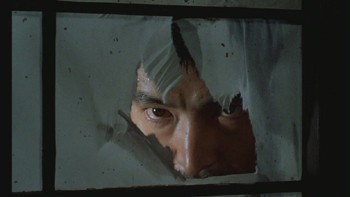 | 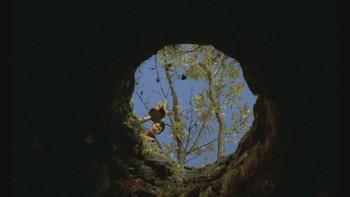 |
Those familiar with the many levels of Japanese horror, from Masaki Kobayashi's Kwaidan itself to modern pieces like Ju-on (The Grudge) and Ringu (The Ring), will have an easy time grasping the notion that subtle ambient suspense and well-conceived photography are Oshima's primary tools at play in his stab at at campfire folklore. It's a traditional Japanese ghost story through and through, with regret and temerity as the essentials intermingled within the compartmentalized narrative. The plot is simple and streamlined with little development, instead relying on both traditional storytelling and Oshima's fervent connection with eroticism as its draws. It's not geared to surprise us as much as it's out to mildly thrill underneath a layer of compelling dramatics bouncing between the leads and a supple sense of aesthetic atmosphere. Though the drama within Seki's love triangle compels to a few mild degrees, the dynamics between them achieve much more once the supernatural elements sneak into the picture. Watching Seki fetch high-content alcohol for her ghostly husband in the middle of the night, along with hearing his voice during an reenacted situation with Toyoji to respark their relationship, transforms Oshima's tone into one of dark comedy and foreboding, swelling tension.
Yoshio Miyajima's cinematography work in Empire of Passion becomes a key element behind its memorable vibe, as it paints the story with equally beautiful and eerie mise-en-scene. With Oshima's eyes for visual motifs, the two blend several symbols together for dramatic effect, one of the most obvious metaphorical symbols is the usage of the circle to emphasize the cyclical nature of the film. Through rotating wheels and the opening at the top of a well in which we see the seasons changing, it conveys a sense of fluid movement throughout time in a striking fashion. It might not sound like much of a time dynamic to watch rickshaw spokes spin and a mixture of leaves and snowflakes fall into a watery grave, but they interact with the traditional "kaidan" elements in an immensely engaging fashion. Also, it's obvious that Oshima really made an effort to make his ghost story a more accessible film through the camera work, as it covers up the minimal sexual content with strategically-placed jettison planks of wood and pieces of fabric -- along with thoughtfully-arranged body parts and shadows.
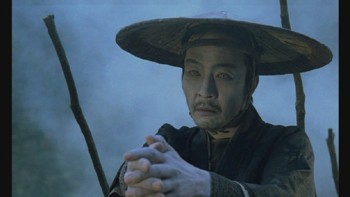 | 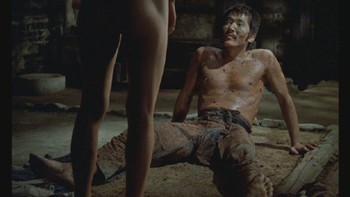 |
Unlike In the Realm of the Senses, Empire of Passion takes on a more conventional form with the male-female dynamic. Where Sado Abe, the lead in Oshima's precursory film, takes on a dominant and violent disposition in her relationship, Seki takes very few strides to exercise any dominance in her relationships -- both with Toyoji and her husband. Instead, they only share a similar desperation in common, showcasing how Oshima focuses on the theme of feeling trapped underneath tradition and commonplace practices in different ways. Seki, as a character, doesn't stray far from gender archetypes put into motion with Japanese cinema's portrayal of 19th century women at the time, but she does show a few glimmers of breaking the mold within her murderous act -- though it was under the pressure of Toyoji. It's in their fleeting desperation, a glance at ensnaring something potent in a time of monotony, that their misguided relationship delivers a dose of potency revolving around the confusing, overwhelming and only partly gratifying nature of desire.
Empire of Passion communicates similar messages to In the Realm of the Senses regarding the consuming nature of sexual transgressions, but Oshima's decision to take it down a more convivial path as a ghost story wedged within tradition was a wise choice. In his decisions to tame that desire to create purely provocative cinema, he also allows some of his political concepts to be more readily accessible and discernible to the naked eye -- especially graspable once the film starts to crash towards its imminent conclusion. Through the eyes of Japanese horror fans and those whom appreciate classic ghost stories, it'll satisfy in all the same ways while adding dashes of Nagisa Oshima's erotically charged elucidations into its satisfying construction. Once you've seen the likes of the director's more aggressive neo-erotica, politically motivated experiment, it'll feel like a chill-inducing walk in the park -- and an immensely enjoyable one in the vein of other "kaidan" pictures of its ilk. As an avid fan of that particular genre, in both classic and contemporary concoctions, Empire of Passion left me gripped.
The DVD:
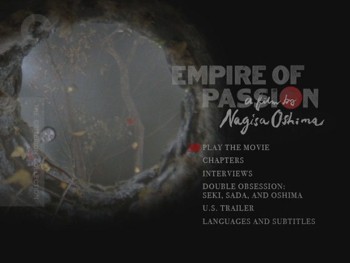 | 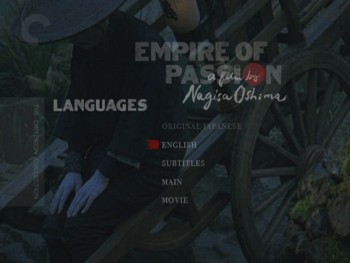 |
Empire of Passion comes presented in the Criterion Collection as spine #467 with attractively-designed artwork packaged in a standard clear keepcase. Inside is a rather beefy Booklet that contains still photographs from the film spliced in with several textual bits, including the essay "Love's Phantom" from critic/historian Tony Rayns (voice of the commentary from In the Realm of the Senses) and an interview from 1978 featuring Nagisa Oshima.
Video and Audio:
Criterion delivered a whopper of a transfer with their Blu-ray image for In the Realm of the Senses (reviewed here), and Empire of Passion -- though only available in a standard-definition treatment -- showcases the same level of concentration in color and detail levels. Presented in a densely saturated 1.66:1 anamorpic widescreen image, taken from the original 35mm camera negative through their Spirit Datacine process, it looks simply gorgeous. One of the best compliments dished out for older film transfers comes in saying that the image appears as if it has the same sort of polish that modern films have, a property that can easily be connected with this visual treatment.
Textures are etched out with eye-popping precision, the range of colors fluttering in the image throughout all seasons showcase splendid contrast and gradation, and the level of grain never oversteps its bounds beyond a natural film essence. The most impressive part of the transfer comes in its incredible depth of field rendering, which gives the image a remarkably three-dimensional feel highly noticeable in exterior shots. A few very, very mild instances of edge halos can be spotted in the starkly contrasted sequences and some mild grayish tinting in the generally inky shadows can be detected, but outside of that Empire of Passion offers its viewers an incredible exercise in dimensionality and color accuracy for a film from the late '70s.
A Japanese Mono track, defaulting to a single-channeled (1.0) track in audio systems, strongly supports the visual treatment. Much like other classic Japanese ghost stories from the '50s to the '70s, it makes excellent usage of the limited audio means -- and Criterion does a surprisingly vivid job in communicating that. Vocal clarity always stands distortion free and well-balanced, while the mild sound effects -- like the flickering of flames, crashing of boards, and the rickety creaks of an old rickshaw -- hold steady and strong even when they can't escape the limited audio presentation's hollowness in sound replication. Moreover, the musical accompaniment sounds equally as ambient and beautifully rendered, supporting the eerier sequences with all the proper musical cues and audibility levels.
Subtitles, which are typically excellent from Criterion, are only available in English to support the Japanese Mono track -- and, oddly, a mediocre English dub, an element that the label typically steers away from. For reference, the subtitles are not taken directly from the dub, and vice versa.
Special Features:
Interviews:
 Two interview pieces are available, one newly-constructed piece with Tatsuya Fuji and Kazuko Yoshiyuki (17:04, 16x9) and another from 2003 entitled On the Set (13:17, 4x3) which gathers together production consultant Koji Wakamatsu and assistant directors Yusuke Narite and Yoichi Sai to discuss working with Nagisa Oshima on his films.
Two interview pieces are available, one newly-constructed piece with Tatsuya Fuji and Kazuko Yoshiyuki (17:04, 16x9) and another from 2003 entitled On the Set (13:17, 4x3) which gathers together production consultant Koji Wakamatsu and assistant directors Yusuke Narite and Yoichi Sai to discuss working with Nagisa Oshima on his films. Both of them gather together the footage shot in the interviews from In the Realm of the Senses' supplements and edits them together in a similar fashion -- with footage from the film spliced in to emphasize topics discussed. Their discussion ranges from the differences in nudity and sex between Oshima's pictures, what it was like working with the idyllically-minded director on a day-to-day basis, and about scene-specific motivators, like Fuji's ramming into a wooden door and Yoshiyuki's de-robing. Moreover, the graphic and disheartening ending is also discussed in rather great length. On the Set takes a more assembly-minded approach, discussing the usage of Gisaburo's ghost in the picture and the connection between Oshima's style and French New Wave cinema.
Double Obsession: Seki, Sada, and Oshima (20:16):
Diving into the theory behind the picture, historian and critic Catherine Russell shares her dissection, connection, and overall thematic takeaway about Empire of Passion and In the Realm of the Senses in this terrific essay. She discusses the similarities in content between the pictures, the symbolism behind wheels and circles as time mechanics, as well as the ways in which Oshima tamed his voyeuristic eye for Empire of Passion. Though a little long for being a purely text-based listen with spliced footage from the film, it's a nice alternative to the lack of full-length commentary on the disc. A chapter Index is made available to skip ahead to specific themes and mechanics within the film.
Finally, we've also got a non-anamorphic U.S. Trailer (1:52) to accompany the picture, which showcases some of the extensiveness that Criterion had to endure in order to clean up and polish Empire of Passion for its presentation here.
Final Thoughts:
Those that were turned away from Nagisa Oshima after catching a glimpse of In the Realm of the Senses owe it to themselves to give Empire of Passion a screening. Taking his talents into more traditional territory with a Japanese ghost story, Oshima exhibits clever usage of symbols, beautiful imagery amid gorgeously shot visuals, and an overall gripping tone due to the graceful level of tension draped over the picture from its supernatural elements. It's also a much tamer erotic experience than that of his more notorious picture, making it a more accessible and focused film instead of experimental and graphic for political reasons. Moreover, it's a purely enthralling pseudo-horror drama, instead of a blatant cinematic challenge.
Criterion's presentation nails all the right notes as well, presenting the film with stellar visual and aural properties and a strong handful of supplements. Considering the value within the film itself, the digital quality, and the level of context within the supplements as a whole, Empire of Passion comes with a High Recommendation -- even more so for unswerving fans of classic Japanese ghost stories.
|
| Popular Reviews |
| Sponsored Links |
|
|
| Sponsored Links |
|
|
| Release List | Reviews | Shop | Newsletter | Forum | DVD Giveaways | Blu-Ray | Advertise |
|
Copyright 2024 DVDTalk.com All Rights Reserved. Legal Info, Privacy Policy, Terms of Use,
Manage Preferences,
Your Privacy Choices | |||||||









